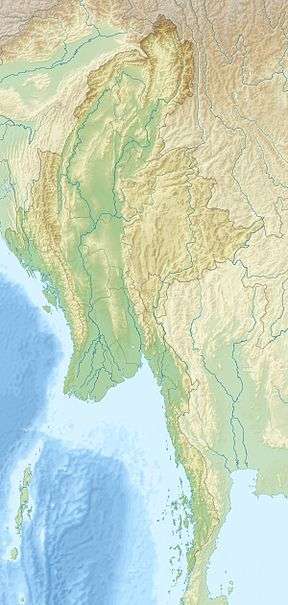Kelatha Wildlife Sanctuary
Kelatha Wildlife Sanctuary is a protected area in Myanmar stretching over 22.45 km2 (8.67 sq mi). It was established in 1942.[1] It harbours evergreen and mixed deciduous forest at an elevation of 0–355 m (0–1,165 ft) in Bilin Township, Mon State.[2]
| Kelatha Wildlife Sanctuary | |
|---|---|
IUCN category IV (habitat/species management area) | |
 Kelatha Wildlife Sanctuary Location in Myanmar | |
| Location | Bilin Township, Mon State, |
| Nearest city | Belin |
| Coordinates | 17°13′00″N 97°7′00″E |
| Area | 22.45 km2 (8.67 sq mi)[1] |
| Established | 1942 |
| Governing body | Myanmar Forest Department |
Location
This sanctuary is near to the town of Taung Sun which is 32 km (20 mi) from the town of Belin. The sanctuary is located on the western side of the Railway line linking Taung Sun and Kyaik Hto railway stations. There are roads all along the boundary of the sanctuary. The topography of the sanctuary is mostly flat with few undulating hills.
Description
The sanctuary receives south-west Monsoon rains every year. The rainfall recorded is about 3,800 mm (150 in) per year. The sanctuary receives heavy rainfall in June, July and August every year.[3] The Shwe Parami Forest Monastery and the Kelatha pagoda is the famous pilgrimage site on the hillock inside the sanctuary. The Keltha Pagoda is situated on 1,181 ft (360 m) high mountain on the edge of the Sittaung lowland Valley. The seaside view from the mountain has made it a major tourism destination.
Area
The area of the sanctuary was 24 km2 (9.3 sq mi) however, due to denotification (degazetment) of 44.81 acres (18.13 ha) for Prison Department housing complex and for mining area of 454.717 acres (1.8 km2) acres for Taung Zun quarry mine , the area is reduced to 5,548.473 acres (22 km2)[4].
Biodiversity
The prevailing forest type in Kelatha Wildlife Sanctuary is mixed deciduous forest and evergreen forest. Teak (Tectona grandis), Antiaris toxicaria, Mesua ferrea, Pygeum anomalum, Ficus oligodon, Diospyros discolor, Baccaurea flaccida, Dipterocarpus alatus are the important tree species. Amherstia nobilis is endemic to Myanmar.
In 1996, Sambar deer (Rusa unicolor), wild boar (Sus scrofa), serow and barking deer species were reported to occur in Kelatha Wildlife Sanctuary.[2] Its fauna comprises 69 bird species, 17 mammals, 71 butterfly species, 12 beetle species and 14 reptile species.
References
- World Database on Protected Areas (2019). "Kaylatha Wildlife Sanctuary". Protected Planet.
- Beffasti, L.; Gallanti, V., eds. (2011). "Kelatha". Myanmar Protected Areas: Context, Current Status and Challenges (PDF). Milano, Yangon: Istituto Oikos, Biodiversity and Nature Conservation Association. pp. 42–43.
- "Climate - Burma". Climates to Travel. Retrieved 28 November 2019.
- "A case study of the ecosystem services rendered by Kelatha Wildlife Sanctuary for the local community" (PDF). Biodiversity and Nature Conservation Association. Retrieved 28 November 2019.